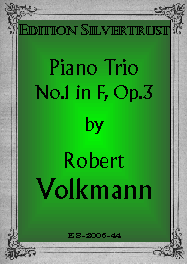Presents
Robert Volkmann
Piano Trio No.1 in F Major, Op.3
 It
was well-known that
when Liszt had a stranger visiting him, for whom he wished to provide a
superlative enjoyment, he played a Volkmann piano trio with Joachim the
famous violinist and the cellist Cossmann. Volkmann's piano trios were held in
the highest esteem not only by the famous, but also by the general musical public
of his time. They were regularly mentioned in the same breath as with those of Beethoven.
High praise indeed for a composer whose works today are nearly all out of print.
It
was well-known that
when Liszt had a stranger visiting him, for whom he wished to provide a
superlative enjoyment, he played a Volkmann piano trio with Joachim the
famous violinist and the cellist Cossmann. Volkmann's piano trios were held in
the highest esteem not only by the famous, but also by the general musical public
of his time. They were regularly mentioned in the same breath as with those of Beethoven.
High praise indeed for a composer whose works today are nearly all out of print.
During his lifetime, Volkmannís music was not only considered the equal of that of Schumann or Mendelssohn, but also more advanced. It was commonly recognized that it was the link between Schumann and Brahms. Ars Longa, vita brevis, as the saying goes, but alas for Volkmann, it was not only vita brevis but also fama brevis!
Friedrich Robert Volkmann (1815-1883) was almost an exact contemporary of Wagner, however, he certainly did not tread the same path as his fellow countryman. He forever kept Beethoven in front of him as his model although he was later to fall under the sway of Mendelssohn and then Schumann. Though born and schooled in Germany, Volkmann, after a brief stint in Prague, got a job in Pest in 1841 and made friends among the large German community there. Though he went to Vienna in 1854, he missed Pest and moved back in 1858 where he remained for the rest of his life.
Piano Trio No.1 was composed in 1842-3 during his first sojourn in Pest, but not published until he moved to Vienna in 1852. The trio begins with a stately Adagio introduction which builds slowly in tempo and emotion and seamlessly leads to the main movement Quasi Andante (where our sound-bite begins) The heavily accented first theme is reminiscent of Beethoven while the second theme is lighter, almost playful. The second movement, Allegretto, is a scherzo and again shows the influence of Beethoven. The slow movement, Andante, is for the most part a calm pastorale, straight forward and simple, although the middle section (our sound-bite) provides a clever contrast in both tempo and emotion without becoming overly dramatic or stormy. The finale, Allegro con fuoco, is clearly the show piece of the trio. It contains three excellent themes, all of which provide excellent contrast. It begins with a highly dramatic and rhythmically swaying subject which suddenly, without any development, gives way to an exciting gypsy theme. Brahms himself later borrowed this technique many times.
Piano Trio No.1 is a fine work, and an excellent example of how Volkmann's music, along with that of Schumann's, is the link between Beethoven and Brahms. Deserving of concert performance, this trio will also give much pleasure to amateurs who will find that it is not beyond their ability.
Parts: $29.95